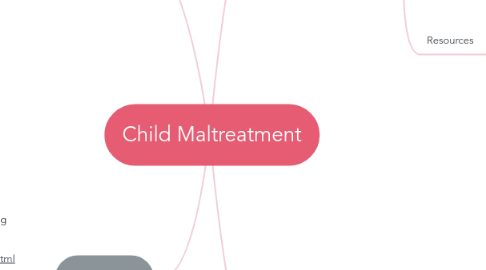
1. Definition
1.1. Child abuse and neglect is any act or series of acts of commission or omission by a parent or other caregiver (e.g., clergy, coach, teacher) that results in harm, potential for harm, or threat of harm to a child (CDC, 2016).
1.2. Types of Child Abuse
1.2.1. Physical abuse. Sexual abuse. Emotional abuse / Psychological abuse. Neglect
2. Resources
2.1. Bales, S. N.(2004). Making the case for childabuse and neglect prevention: A FrameWorks message memo. Washington, DC: FrameWorks Institute. Centers for Disease Control andPrevention.(2016). Strategic direction forchild maltreatment prevention: Preventing child maltreatment through the promotionof safe, stable, and nurturing relationships between children and caregivers. Atlanta, GA: Author. Retrieved from www.cdc.gov/ViolencePrevention/overview/strategicdirections.html Mercy, J. A., & Saul, J.(2009). Creating a healthier future through early interventions for children. JAMA: Journal of the American Medical Association, 301, 1–3. McEwen, B. S. (2007). Physiology andneurobiology of stress and adaptation:central role of the brain. Physiology Review, 87(3), 873–904. Sidebotham, P., & Heron, J. (2006). Child maltreatment in the “children of the nineties”: A cohort study of risk factors. Child Abuse and Neglect, 30, 497–522.
3. Overview
3.1. Risk Indicators & Implications
3.1.1. Risk Factors for Victimization
3.1.1.1. Children younger than 4 years of age Special needs that may increase caregiver burden (e.g., disabilities, mental retardation, mental health issues, and chronic physical illnesses)
3.1.2. Risk Factors for Perpetration
3.1.2.1. Parents’ lack of understanding of children’s needs, child development and parenting skills Substance abuse and/or mental health issues including depression in the family Parental characteristics such as young age, low education & income, single parenthood
3.1.3. Family Risk Factors
3.1.3.1. Social isolation Family disorganization, dissolution, and violence, including intimate partner violence Parenting stress, poor parent-child relationships, and negative interactions
3.1.4. Community Risk Factors
3.1.4.1. Community violence Concentrated neighborhood disadvantage Poor social connections
3.2. Statistical Data
3.2.1. There were 702,000 victims of child abuse and neglect reported to child protective services (CPS) in 2014. The youngest children are the most vulnerable with about 27% of reported victims being under the age of three. 1 in 4 children experience some form of child abuse or neglect in their lifetimes. About 1,580 children died from abuse or neglect in 2014. The total lifetime cost of child abuse and neglect is $124 billion each year
3.3. Resources
3.3.1. https://www.acf.hhs.gov/sites/default/files/cb/cm2014.pdf https://www.childhelp.org/ https://vetoviolence.cdc.gov/apps/phl/docs/A_Better_Start.pdfv
4. Strategies
4.1. Resilience Indicator
4.1.1. These traits include easy temperament, secure attachment, basic trust, problem solving abilities, an internal locus of control, an active coping style, enlisting people to help, making friends, acquiring language and reading well, realistic self-esteem, a sense of harmony, a desire to contribute to others, and faith that one's life matters (Davis, 2001).
4.2. Strategy
4.2.1. Strengthen economic supports to families
4.2.1.1. Strengthening household financial security Family-friendly work policies
4.2.2. Intervene to lessen harms and prevent future risk
4.2.2.1. Enhanced primary care Behavioral parent training programs Treatment to lessen harms of abuse and neglect exposure Treatment to prevent problem behavior and later involvement in violence
4.3. Team-base Approach
4.3.1. Community Outreach
4.3.2. Public Education
4.4. Resources
4.4.1. https://www.childwelfare.gov/preventing/evidence/ https://www.thecommunityguide.org/ http://www.promisingpractices.net/programs_topic_list.asp
